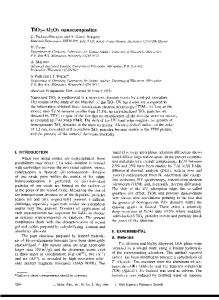Microstructural Characterization and Strengthening-Toughening Mechanism of Plasma-Sprayed Al 2 O 3 -Cr 2 O 3 Composite C
- PDF / 1,462,549 Bytes
- 14 Pages / 593.972 x 792 pts Page_size
- 104 Downloads / 337 Views
ai Yang, Jingwei Feng, Xiaming Zhou, and Shunyan Tao (Submitted December 4, 2011; in revised form February 29, 2012) In this study, Al2O3, Cr2O3, and Al2O3-Cr2O3 coatings were fabricated by plasma spraying. X-ray diffraction was employed to determine the phase composition of powders and coatings. The morphologies and microstructures of the coatings were characterized using electron probe microanalyzer and transmission electron microscopy. Vickers hardness, fracture toughness, and bending strength of the coatings were measured. Al2O3-Cr2O3 composite coatings show better comprehensive mechanical properties than the individual Al2O3 and Cr2O3 coatings, which are attributed to the former’s larger intersplat adhesion or interlamellar cohesion and lower porosity. Solid solution strengthens the phase interfaces and grain boundaries, which is beneficial to improve the mechanical performance of the composite coatings.
Keywords
Al2O3-Cr2O3 composite coatings, microstructure, plasma spraying, strengthening-toughening mechanism, transmission electron microscopy (TEM)
1. Introduction Plasma-sprayed Al2O3 coatings are regarded as the representative of oxide ceramic coatings, which shows good mechanical and anti-wear properties (Ref 1, 2). It has been noted that sintered Al2O3 ceramics and plasmasprayed Al2O3 coatings possess different phase contents, even though all the feedstock powders commonly used consist of a-Al2O3 (corundum). The crystalline structure of sintered Al2O3 is stable a-Al2O3; however, Al2O3 coatings produced by plasma spraying are mainly composed of metastable c-Al2O3 (Ref 3, 4). The corresponding phenomenon and phase transformation mechanism were studied by Ault and McPherson (Ref 5-7). The lower nucleation energy needed for c-Al2O3 than a-Al2O3 in the rapidly quenched, plasma-spray droplets results in the obtained Al2O3 coatings with metastable structure.
Kai Yang, Xiaming Zhou, and Shunyan Tao, The Key Laboratory of Inorganic Coating Materials, Chinese Academy of Sciences, Shanghai 200050, PeopleÕs Republic of China; and Shanghai Institute of Ceramics, Chinese Academy of Sciences, Shanghai 200050, PeopleÕs Republic of China; Jingwei Feng, Shanghai Institute of Ceramics, Chinese Academy of Sciences, Shanghai 200050, PeopleÕs Republic of China; and Inorganic Materials Analysis and Testing Center, Shanghai Institute of Ceramics, Chinese Academy of Sciences, Shanghai 200050, PeopleÕs Republic of China. Contact e-mail: [email protected].
Journal of Thermal Spray Technology
Despite this phase transformation, Al2O3 coating properties are still acceptable for many applications. However, the presence of c-Al2O3 combined with porosity and substrate characteristics may drastically change the coating’s performances (Ref 8, 9). The prevention of this phase transformation could be expected to significantly enhance the coating behavior. For Al2O3 coatings, the formed metastable phases can be either partially or fully transformed into the a phases by heat treatment (Ref 10). The complete back-transformation into th
Data Loading...











